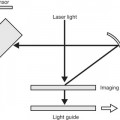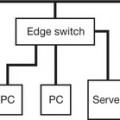17 Ultrasonography
| Ultrasonography is the formation of a visible image from the use of ultrasound. A controlled beam of sound is directed into the relevant part of the body and the reflected ultrasound is used to build up an electronic image of the various structures which can be viewed on a monitor |
| Piezoelectric Crystal |
• Quartz crystal
• When electric current is applied it vibrates and emits sound waves
• When a sound wave hits the crystal it emits an electric current
|
| Transducer (Probe) |
• Produces and sends sound waves
• Receives reflected echoes from boundaries between tissues
• Has a sound-absorbing backing to stop sound being reflected from the probe
• An acoustic lens to focus the sound waves
• Shape of the probe gives the field of view (footprint)
• Frequency of the sound wave determines the depth the wave will travel and the image resolution
• The higher the frequency the better the resolution (but more of the beam is absorbed by the tissues therefore the depth of penetration of the beam is reduced)
• High frequencies (7.5 megahertz, MHz) are used for superficial organs, e.g. breast and thyroid
• Lower frequencies (3.5 megahertz, MHz) for the abdomen
• Can contain one or more than one crystal element
• Each crystal has its own electrical circuit
• In multiple element probes the individual crystals can receive signals at different times
• Smaller probes can be used in the vagina, rectum, oesophagus, etc.
|
| Transducer Pulse Controls | Allow the setting of: |
• The frequency of the pulses
• The time of the pulses
• The scan mode of the machine
Central Processing UnitContains
• A computer – containing a microprocessor and memory
• Amplifiers
• Power supplies to the microprocessor and transducer
Function
• Sends electrical currents to the transducer
• Receives electrical pulses from the transducer – created by the returning echoes
• Processes the data
• By using the speed of sound through tissue (1540 metres per second) and the time taken for the echo to return
• Displays the image on the monitor
• Stores the final image
DisplayCan demonstrate
• Shades of grey
• Colour
• Movement
• Two dimensional images
• Three dimensional images
• Surface rendering
• Transparency mode
| Acoustic Impedance |
• A value given to a substance
• Is calculated by multiplying the density of the medium by the velocity of the ultrasound travelling through the medium
• It is independent of frequency
• When a sound wave hits a substance with a different acoustic impedance part of the wave is reflected back
|
| Acoustic Window |
• An area of the body used to allow imaging of underlying structures, e.g. the spaces between the ribs, the liver
|
| Aliasing |
• When high velocities in one direction appear as high velocities in the opposite direction
• Occurs when an analogue signal is sampled at a frequency which is lower than half its maximum frequency
• All the frequency above half of the sampling frequency is projected below the base line (backfolded) in the low frequency region causing artifacts on the image
|
| Amplitude |
• The maximum value of either positive or negative current or voltage that occurs on an alternating current waveform
• The magnitude (height) of the ultrasound beam
• The ultrasound pulse is very brief so the power values arranged over a period of time will be low compared to peak intensity
|
| Coupling Gel |
• A gel put on a patient’s skin to exclude any air between the transducer and the skin surface
• Done to enable the transmission of ultrasound waves between the transducer and the patient
|
| Doppler Effect | When imaging a moving object: |
• The frequency of the reflected beam is changed by the movement
• If the object is moving towards the probe the frequency will be increased
• If the object is moving away from the probe the frequency is decreased
• The speed of change of the frequency indicates how fast the object is moving
Doppler Scanner
• Equipment used to monitor a moving substance
• Measures the change in frequency of the reflected echoes to determine the speed of movement of the object, e.g. the fl ow of blood or the beating heart
Echo
• The refl ection of an ultrasound wave back to the transducer
• Occurs when the beam hits a surface at right angles
Fourier Transform
• A method of mathematically changing data, e.g. changing spatial data to frequency data
• Spatial data gives the position of the varying intensities (brightness) across an image
• Frequency data is number and frequency of sine and cosine waves forming the image
Frequency
• The number of cycles of alternating current that occur in one second
• Measured in Hertz (Hz)
• Ultrasound is frequencies beyond 20 kilohertz (kHz)
Nyquist Theorem
• States that an analogue signal waveform may be reconstructed without error from a sample which is equal to, or greater than, twice the highest frequency in the analogue signal, e.g. to digitally convert a 2 MHz signal a sample must be taken at 4 MHz
Phased Array
• A sector field of view with multiple transducer elements
• Formed in precise sequence and under electronic control
Stay updated, free articles. Join our Telegram channel

Full access? Get Clinical Tree






